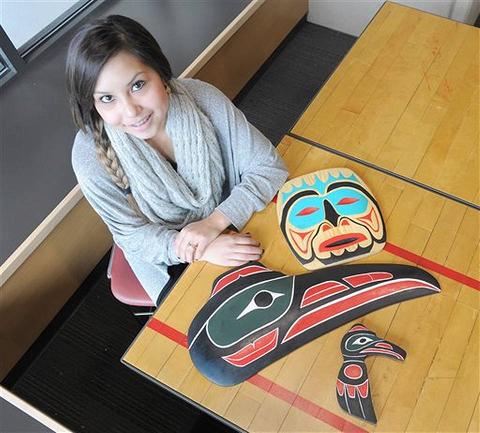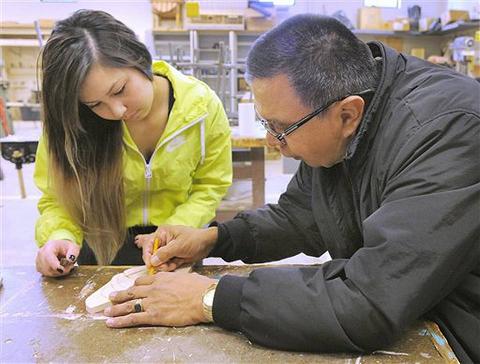 |
Canku Ota
|
 |
|
(Many Paths)
|
||
|
An Online Newsletter
Celebrating Native America
|
||
|
February 2016 - Volume
14 Number 2
|
||
|
|
||
|
School Districts
Add Native American Culture To Curriculum
|
||
|
by Kera Wanielista -
Skagit Valley Herald
|
||
MOUNT VERNON, WASH. — Though a channel divides the town of La Conner from the Swinomish Indian Tribal Community reservation, the two cultures are intertwined in Michael Carrigan's shop class at La Conner High School. His file cabinets are full of traditional Native American imagery — pictures of salmon, orcas and ravens. In a heartbeat, Carrigan can pull out examples of student-made tools and drums. For their final projects, students carve totem poles that tell their own stories. "It's good for keeping some of the skills alive," Carrigan said. "It generates an awareness, which creates a respect for other cultures." In La Conner schools, the cultural collaboration between the district and the tribe is a way of life. "The Swinomish tribe and La Conner schools have worked together for a very long time," said Peg Seeling, who is the district's director of teaching and learning, as well as its director of assessment. "It's amazing how much history they have together." Thanks to a newly modified state law, school districts throughout the state are now figuring out how to be more like La Conner. Passed during the 2015 legislative session, the law requires schools to incorporate a state-created curriculum, called Since Time Immemorial, to enhance what students learn about Washington's 29 federally-recognized tribes. In Carrigan's classroom, junior Nakesha Edwards is focused on a piece of cedar, carving it into what will soon become a bird. "It relaxes me," the 16-year-old said of woodworking.
Carving is a skill Edwards is refining in the classroom, but it's an art she learned from her uncle, Swinomish Senator Kevin Paul, who has co-taught classes with Carrigan for more than a decade. "I want to share the gift of the knowledge that was handed down to me," Paul said. Before coming to La Conner, Edwards said lessons about her culture weren't something she was taught. "People should learn about our ways," Edwards said. "But they should learn about different ways as well. Come in with an open mind." The curriculum is intended to create more opportunities for all kids throughout the state to learn about Native American history and how it has helped shape Washington. "The intention of the curriculum is to benefit all kids in public education," said Michael Vendiola, program supervisor for the Office of Superintendent of Public Instruction's (OSPI) Office Of Native Education. "This is not about focusing only on one particular student group. It's filling in some of the missing information about the tribal community to the Washington state story." Vendiola has personal experience with some of that missing information. A member of the Swinomish tribe, Vendiola said he's always had a strong connection to his culture through his tribe. He didn't attend La Conner schools, and the schools he attended didn't teach his culture at the same level as his tribe. "It was a minimum," he said. "And it was presented in a past tense, as if myself, as a person who identified as a Native American, didn't really exist in the current society. It was about looking at the past and more of like an anthropological look at how our people lived a long time ago." That perspective does a disservice to all students, Vendiola said. "It leaves a tremendous hole in the story of what makes us Washington state," he said. "That's what we feel is really important about implementing this curriculum is that it tells a broader story." The Since Time Immemorial curriculum addresses sovereignty, treaties and court rulings. They are topics tribes and neighboring communities deal with every day. "The typical U.S. history book does not adequately or appropriately cover Native American culture," Seeling said. "One-third of our kids are Native. We want to do it right." Paul agreed. "Having this curriculum in place, (students) will have a different view of what an Indian is and where they come from," he said. "According to the old textbook, we still live in tepees. We're still 'wild' people." The move toward a more complete Native American curriculum at the state level began in 2005, Vendiola said. At that time, the Legislature passed a law saying the districts' implementation of the Since Time Immemorial curriculum was "encouraged." Only two districts, Marysville and Fife, officially adopted the curriculum at that time, he said. In its 2015 session, the Legislature made implementation of the curriculum mandatory. "This shift to requiring it, I think recent history proves how necessary that is," said K.C. Knudson, executive director of teaching and learning for the Burlington-Edison School District. "I don't think we were doing our best prior to legislation change." The curriculum is free to school districts and available online. The districts are encouraged to adapt it to best fit their schools, Vendiola said. "I would say folks are adopting it in innovative ways," he said. OSPI also offers free training sessions. The curriculum is meant to enhance lessons already taught in fourth-, seventh- and 11th-grade social studies classes, but can be expanded to fit all grades. Districts are also encouraged to adapt the curriculum to their local tribes, an idea Knudson said is important for deeper understanding. "Some of the most egregious errors that I think we made were not valuing our local tribes as resources," he said. "Here we are with kids in our classrooms that are living, breathing resources, with family members at home that are also living, breathing resources." The Burlington-Edison School District hopes to include the Upper Skagit Indian Tribe and the Swinomish tribe in further development of the curriculum, Knudson said. "Our kids, unlike La Conner, have less direct exposure (to tribal culture)," he said. "I feel like that almost makes the work more pressing here, so that we understand our neighbors and the richness of the whole Skagit Valley." Sedro-Woolley School District Assistant Superintendent Mike Olson said his district will look to the Upper Skagit tribe to guide its implementation as well. "There are a number of tribes in Washington state, and it's inappropriate to overgeneralize that every tribe is the same," he said. The Upper Skagit tribe could not be reached for comment. All 29 federally-recognized tribes in the state have endorsed the state-created curriculum, Vendiola said. "This is a collaboration between the state and the tribes," he said. "Both financially support these free trainings. The tribes continue to support this effort to build stronger relationships." With the passage of the law, the La Conner district will expand on what it already does and incorporate Swinomish culture into more lessons, Seeling said. "We're not just doing it because it's the law," she said. "We're doing it because it's an important part of our school culture." With participation from the Swinomish tribe, the district is looking at incorporating the curriculum across all grades and subjects, especially when it comes to science and environmental studies, Seeling said. The Swinomish tribe has formed a committee to work with the district to implement the best practices for teaching not just the Native American story, but the Swinomish story, said Tracy James, education director for the tribe. "It would give us the ability to teach our children directly what our Swinomish tribe is about," James said. "From our constitution, to our culture, to our history." While the district will focus on K-12 implementation, the tribe will go further, beginning with teaching Swinomish preschoolers the tribe's Lushootseed language and working with Northwest Indian College to further train teachers in the language. "Children who know about their culture and history do better in school," James said. "If we can give them a sense of place and a sense of history, research shows that native kids will do better." |
||||
|
|
|
|
||
|
|
||
| Canku Ota is a free Newsletter celebrating Native America, its traditions and accomplishments . We do not provide subscriber or visitor names to anyone. Some articles presented in Canku Ota may contain copyright material. We have received appropriate permissions for republishing any articles. Material appearing here is distributed without profit or monetary gain to those who have expressed an interest. This is in accordance with Title 17 U.S.C. Section 107. | ||
|
Canku Ota is a copyright ©
2000 - 2016 of Vicki Williams Barry and Paul Barry.
|
||
 |
 |
|
|
The "Canku
Ota - A Newsletter Celebrating Native America" web site and
its design is the
|
||
|
Copyright ©
1999 - 2016 of Paul C. Barry.
|
||
|
All Rights Reserved.
|
||

